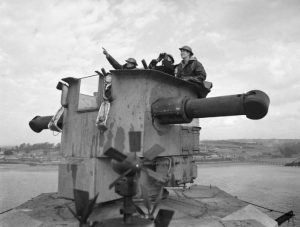- Author
- Haynes, Fred
- Subjects
- Naval technology
- Tags
-
- RAN Ships
- None noted.
- Publication
- September 2018 edition of the Naval Historical Review (all rights reserved)
Before the days of radar an array of optical rangefinders was an important feature of nearly all warships. In Royal Naval vessels, including those of the Dominions, these were mostly made by the Glasgow firm of Barr & Stroud and rangefinders fitted in RAN ships were returned to the makers for repairs and calibration. As this was time consuming and expensive a decision was made in the early 1920s to conduct future rangefinder maintenance and repairs locally at Garden Island Dockyard.
It was not until 1925 that a site for a repair shop was selected and built on the northern hill alongside the signal station with access by Hill Road past the dockyard residences. This site presented long and uninterrupted views down harbour.
Tradesmen, including a foreman with required expertise, were recruited in the United Kingdom, most likely poached from Barr & Stroud. As optical work had previously been conducted by the Dockyard on submarine periscopes there was some level of local experience already available. This existing work had been carried out in the electrical workshop near the dominant shear-leg crane.
The largest rangefinder then fitted to capital ships such as the battle-cruiser HMAS Australia was the FX3 which measured 22 feet (6.7 m) in length. To enable these large instruments to be repaired and calibrated a special jig was sent out by Bar & Stroud and fitted along the eastern side of the new hillside repair shop. This enabled the water tower on Dover Heights and other similar landmarks to be used for calibration, with Clark and Shark islands used for closer ranges. In 1930 a two storey addition to the original building was completed, enabling all optical and mechanical instruments in the RAN inventory to be repaired locally.
With the WWII development of radar, optical range-finding became obsolete. The last RAN ships capable of being fitted with rangefinders within their directions systems were the HMA Ships the DDGs Brisbane, Hobart and Perth. However, as weight restrictions to these particular ships were imposed by the incorporation of the Ikara ASW missile system, their rangefinders were not installed. Photographs of these DDGs show that the directors have blanking discs where the rangefinders should have protruded.
This just left the smaller one metre base rangefinders used by ships for navigational purposes. These smaller instruments required much closer targets for calibration which included the top of the staircase on the western side of the Dockyard Chapel and the northern end of the Finger Wharf at Woolloomooloo Bay. For longer ranges the closest of the twin flagstaffs on top of the Harbour Bridge was used.
With the construction of a new Weapons Building (No 79) in 1969 the optical workshop was sited on the top level of this building with a new periscope workshop on the level below.
This did not last long: with the further construction of a new Integrated Weapons Workshop along the western side of the Captain Cook Dock in 1987 the limited work on rangefinders continued here until the closure of the Optical and Periscope workshop in 2010. So ended 85 years of local technical support by Garden Island Dockyard for the maintenance of optical instruments.





